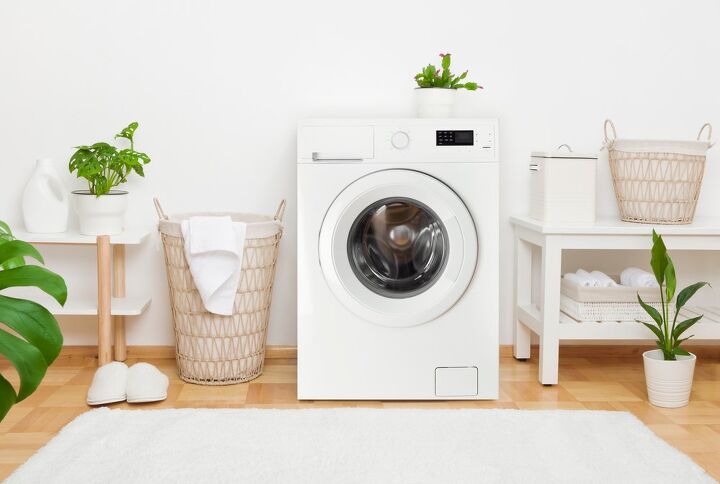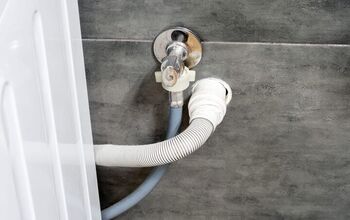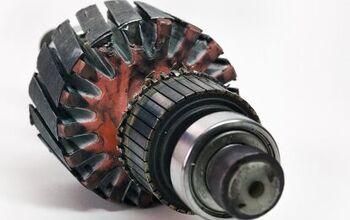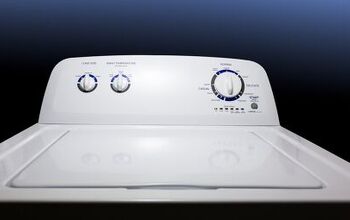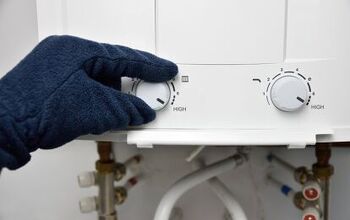How Much Water Does A Washing Machine Use?

We are all more aware of the amount of water we use now compared to years ago when it did not seem to matter at all. Our kids ran around in the sprinklers for hours without anyone thinking we were wasting too much water. But what about when we wash our clothes? How much water does your washing machine use?
The modern washing machines we have today are using much less water than the old ones. For example, 20 years ago a washer may have used 30 gallons of water while today they use about 10 gallons or less. In fact, some newer washing machines only use about seven gallons.
Do You Need Appliance Repair Services?
Get free, zero-commitment quotes from pro contractors near you.

EPA Regulations Set the Limits
One of the reasons why the amount of water used by washing machines is less is because of the law. The Environmental Protection Agency (EPA) regulations have gotten stricter over the years. The amount of water that a washer can use has to be 26 gallons or less to comply with the energy star ratings.
Additionally, when a machine is ENERGY STAR certified, it means that uses 25% less energy and 33% less water than traditional washers.
Factors Impacting Washing Machine Water Usage
Ultimately, the amount of water that a washing machines uses varies based on a number of factors, including:
- Load Size
- Washer Capacity
- Cycle Settings
- Style and Age of Washing Machine
Let’s examine each of these factors in detail to better understand how they influence a washing machine’s water usage.
Load Size
The size of the load is a crucial factor in washing machine water usage. A medium-size load is approximately six pounds, or roughly the amount of clothes you could hold in your arms. Whereas, a large load is around 11 pounds and an extra-large load is approximately 21 pounds.
Overall, the larger or bulkier the articles, the more water that will be needed to effectively clean the clothes.
Washer Capacity
Another factor that impacts a washing machine’s water usage is the size of the machine, which is measured in terms of cubic feet of the tub. Most standard-sized washers have a capacity of three to four cubic feet, while larger capacity washers may be more than five cubic feet. Though, generally speaking, the larger the capacity, the more water the washer can hold.
That said, according to ENERGY STAR, here’s how much waster washers use based on their capacity:
- Washers with a capacity of less than 4 cubic feet use about 8.5 gallons of water each load, on average.
- Washers with a capacity of 4 to 5 cubic feet use about 15.6 gallons of water each load, on average.
- Washers with a capacity of more than 5 cubic feet use about 20.5 gallons of water each load, on average.
Cycle Setting
The cycle that you select, including any extra rinse settings, can also impact how much water your washing machine uses. Make sure that you always choose the cycle based on the types of clothing that you’re washing. If you don’t, your clothes may not get clean, which forces you to run an additional cycle and use up even more water in the process.
If your machine is equipped with a water-saving or eco-friendly cycle, it will be efficient enough to clean your clothes while also conserving energy and water at the same time.
Style and Age of Washing Machine
Generally speaking, older machines use water less efficiently than newer models. In fact, modern styles, like High Efficiency (HE) or front-loaders, offer exceptional water efficiency. Most are usually ENERGY STAR certified as well.
The Difference Between Washing Machines
In the past, you basically had a choice of top loader or front loader and that was it. Nowadays, you can choose those as well as a standard or high-efficiency washing machine. You can also choose from an agitator or impeller. Add that to the fact that there are more than two dozen major brands, you could spend months trying to make up your mind.
Top Loader
The top-loading washing machine has been around since the 1930s and became a commonality in homes quickly. They are simple, just open the top of the lid and put the clothes in, toss in some soap, and turn it on. They typically use an agitator, which is a cylinder in the center of the machine that moves your clothes around to get them clean.
Front Loader
The front loader works similar to a dryer, moving the clothes with paddles as the drum spins. The water and soap flow over the clothing as they tumble around, getting them cleaner without so much agitation to damage your clothes. They also use less soap and dryer times are shorter because the clothes come out dryer than with top loaders.
Front-loaders take longer to wash than top load washers though. The average time is about 90 minutes whereas the average time for a top load washer is about 45 minutes. Mold can also be a problem in front load washers. But if you do regular maintenance, that should not be a problem.
Standard
This type of machine has been the norm since the late 1930s and is always a top-loading machine. They use an agitator and spin the clothes back and forth in the water to get them clean. This is the standard way to wash clothing and was thought to be the best way until the high-efficiency machines came out.
These types of machines use more water than high-efficiency machines as well as more energy. They are also rough on your clothing and can be noisier than high-efficiency washers.
High Efficiency
Recently, because of new energy standards, almost all washing machines made are high-efficiency models. They use a lot less water and energy, so they meet the regulations set by the EPA. Top loading standard machines could not do that. Because they use less water, they also use less detergent, which saves you money as well.
Agitator
The agitator is rough on your clothing as it pulls and pushes it back and forth. Sometimes, clothing gets stuck on the agitator and can pull them out of shape, tear off buttons, and pull strings loose. Most new washing machines are now made with the impeller instead.
Impeller
In both top and front-loading machines, the impeller is a better choice as it cleans by letting the clothing rub against each other rather than by pushing and pulling it around. The impellers also use much less water, less soap, and way less energy.
There are downsides to the impeller in top-load machines. They take a lot more time (sometimes going as long as 90 minutes) and the clothing can get tangled together. However, if you put the clothes in properly, that should not be an issue.
Most Efficient Washing Machines
Front-loaders use the least amount of water, with the average being seven gallons per load. A high efficiency (HE) top-loading washing machine uses approximately 13 gallons of water. But the average top loader uses 19 gallons of water. Here are some of the top examples of washing machines and the amount of water they use per load.
| Washing Machine | Gallons Used | Average Price |
Whirlpool WTW8000D Top Load | 22.7 | $1,000 |
Maytag MVW7230H Top Load | 22.5 | $800 |
Samsung WA52J806*A* Top Load | 18.5 | $900 |
Electrolux EFLS627 Front Load | 14.1 | $900 |
LG WM3080C* Front Load | 13.7 | $600 |
Kenmore 592-4961* Front Load | 13.3 | $700 |
GE GFW400S*M* Front Load | 13.1 | $550 |
Gaggenau WM262700 Front Load | 8.0 | $1,100 |
Bosch WAT28400UC Front Load | 7.8 | $1,000 |
Beko BWM7200X Front Load | 7.0 | $850 |
Washer Dryer Combos
If you do not have much space for laundry, you may want to try the newest types of washing machines, the washer dryer combo. It is one machine that does both and does it well. Toss your clothes in to wash and come back a few hours later to clean and dry clothes, ready to wear. The only thing it does not do is fold them.
The dryer uses a heat pump or condenser to remove the water from your clothing after the washing is done. However, it is much more expensive and takes a lot longer. It also only does small loads. But it takes up way less space and you do not have to unload the washer into the dryer ever again.
Stacking Washing Machines
Having a stacked washer and dryer can be an amazing convenience for saving space as well. You can choose the small compact size or the full-sized machines. Either way, you save a lot of room and with a pedestal, you can easily reach the doors to both of the machines.
Some Other Washing Machine Features
Even though most of these other features have nothing to do with how much water is used, they are important features as well. These features include:
- Automatic dispensers are seriously amazing, and most are able to handle the detergent, fabric softener, and bleach. In fact, many can hold enough to do a dozen washes without adding anything at all.
- Digital display that shows how much longer your wash has to go
- Time delay is a fantastic feature that will let you delay the start time so it will run while you are sleeping or at work. Or, in some cases, when water use is cheaper.
- Load detection actually does have something to do with saving water because it weighs your load to select the best wash cycle for the weight.
- Child locks are essential for houses with young children. The lock prevents the door from closing or from starting.
- The easy-iron feature prevents wrinkles in your clothing by shortening the spin cycle.
- Anti-allergen uses steam or high-temperature water to remove bacteria and allergens.
- Extra rinse is good for allergies as well since the extra rinse cycle gets rid of any excess detergent that can bother your skin.
- Smart washers are the latest thing. You can get one with Wi-Fi, Alexa, or Google Assistant so you can communicate with your machine as needed. Use your phone to select cycles, start, and stop the washing machine.
Do You Need Appliance Repair Services?
Get free, zero-commitment quotes from pro contractors near you.

What Size Washing Machine Do I Need?
Washing machines come in different sizes so you can get the size you need for your household. For example, a single person or couple would be much better off with a small capacity washer rather than a huge one. And a large household will definitely need a larger drum.
| Size Family | Size Washing Machine |
One to two people | 1 to 3 cubic feet |
Three to five people | 3 to 4.5 cubic feet |
Five or more people | 4.5 to 6 cubic feet |
Take a look at what is in your laundry basket when you do your laundry. Is it full of towels or do you just have a couple? A small washer can handle a couple of towels and a few days’ worth of clothing for one or two people.
On the other hand, if you have a dozen thick towels, 10 pairs of jeans, and a bunch of other clothes, you will definitely need the largest capacity washing machine you can get. Or you will be doing laundry all day.

I am a DIYer who loves writing about anything home-related. When I am not writing, you can find me studying for my PhD in Psychology, photographing nature, and swimming at the lake with my grandkids.
More by Patricia Oelze



